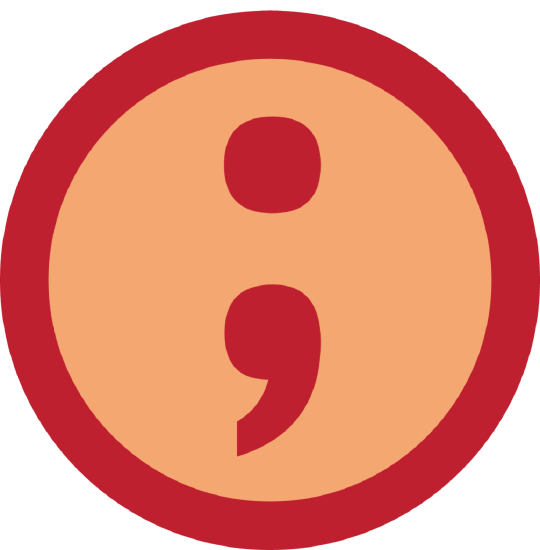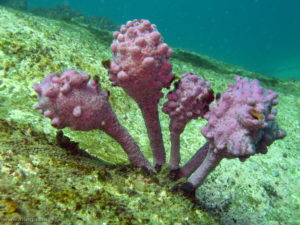23.4: Semicolons and Colons
- Page ID
- 5731
Semicolons

Figure \(\PageIndex{1}\)
The semicolon is one of the most misunderstood and misused punctuation marks; in fact, it is often mistaken for the colon (which we’ll discuss next). However, these two punctuation marks are not interchangeable. A semicolon connects two complete ideas (a complete idea has a subject and a verb) that are connected to each other. Look at this sentence for example:
Anika’s statue is presently displayed in the center of the exhibit; this location makes it a focal point and allows it to direct the flow of visitors to the museum.
The first idea tells us where Anika’s statue is, and the second idea tells us more about the location and it’s importance. Each of these ideas could be its own sentence, but by using a semicolon, the author is telling the reader that the two ideas are connected. Often, you may find yourself putting a comma in the place of the semicolon; this is incorrect. Using a comma here would create a run-on sentence (we’ll discuss those more in Text: Run-on Sentences). Remember: a comma can join a complete idea to other items while a semicolon needs a complete idea on either side.
The semicolon can also be used to separate items in a list when those items have internal commas. For example, say you’re listing a series of cities and their states, or you’re listing duties for a resume:
- As a photographer for National Geographic, Renato had been to a lot of different places including São Paulo, Brazil; Kobe, Japan; Kyiv, Ukraine; and Barcelona, Spain.
- As an engineering assistant, I had a variety of duties: participating in pressure ventilation surveys; completing daily drafting, surveying, and data compilation; and acting as a company representative during a roof-bolt pull test.
Exercise \(\PageIndex{1}\)
Read the following sentences. Determine if the empty spaces need a semicolon, a comma, or no punctuation.

Figure \(\PageIndex{2}\) - Sea Tulips
Pyura spinifera __ commonly called the sea tulip __ is a species of ascidian that lives in coastal waters at depths of up to 260 feet. As with almost all other ascidians __ sea tulips are filter feeders. Its name comes from the organism’s appearance __ it looks like a knobby “bulb” or flower attached to a long stalk. Sea tulips come in a variety of colors, including white, pink, yellow, orange, and purple __ note that __ the coloration of sea tulips depends upon their association with a symbiotic sponge that covers their surface.
You may spot this in ocean waters near Sydney __ Australia __ Central Coast __ Australia __ and Newcastle__ Australia.
- Answer
-
Pyura spinifera _,_ commonly called the sea tulip _,_ is a species of ascidian that lives in coastal waters at depths of up to 260 feet. As with almost all other ascidians _,_ sea tulips are filter feeders. Its name comes from the organism’s appearance _;_ it looks like a knobby “bulb” or flower attached to a long stalk. Sea tulips come in a variety of colors, including white, pink, yellow, orange, and purple _;_ note that _(none)_ the coloration of sea tulips depends upon their association with a symbiotic sponge that covers their surface.
You may spot this in ocean waters near Sydney _,_ Australia _;_ Central Coast _,_ Australia _;_ and Newcastle _,_Australia.
Colons

Figure \(\PageIndex{3}\)
The colon: well-loved but, oh, so misunderstood. The colon is not just used to introduce a list; it is far more flexible. The colon can be used after the first word of a sentence or just before the final word of a sentence. The colon can also be used to introduce a grammatically independent sentence. Thus, it is one of the most powerful punctuation marks.
The colon is like a sign on the highway, announcing that something important is coming. It acts as an arrow pointing forward, telling you to read on for important information. A common analogy used to explain the colon is that it acts like a flare in the road, signaling that something meaningful lies ahead.
Use the colon when you wish to provide pithy emphasis.
To address this problem, we must turn to one of the biologist’s most fundamental tools: the Petri dish.
Use the colon to introduce material that explains, amplifies, or summaries what has preceded it.
- The Petri dish: one of the biologist’s most fundamental tools.
- In low carbon steels, banding tends to affect two properties in particular: tensile ductility and yield strength.
The colon is also commonly used to present a list or series, which comes in handy when there is a lot of similar material to join:
A compost facility may not be located as follows: within 300 feet of an exceptional-value wetland; within 100 feet of a perennial stream; within 50 feet of a property line.
Exercise \(\PageIndex{2}\)
Is the colon used correctly in the following sentences? If not, write the corrected sentence in the text frame below.
- There are three methods of attracting earthworms from the ground: worm charming, worm grunting, and worm fiddling.
- The activity can be performed: to collect bait for fishing or as a competitive sport.
- As a skill and profession worm charming is now very rare: with the art being passed through generations to ensure that it survives.
- In most competitions, the collector of the most worms in a set time is declared as the winner: they usually have a zone in which to perform their charming, measuring three yards square.
- The activity is known by several different names and the apparatus and techniques vary significantly: (1) Most worm charming methods involve vibrating the soil, which encourages the worms to the surface, (2) Worm grunting generally refers to the use of a “stob,” a wooden stake that is driven into the ground, and a rooping iron, which is used to rub the stob, (3) Worm fiddling also uses a wooden stake but utilizes a dulled saw which is dragged along its top.
- Answer
-
- Correct. A colon is used before a list.
- Incorrect. A colon needs an independent clause before or after it.
- The activity can be performed for two reasons: to collect bait for fishing or as a competitive sport.
- The activity can be performed to collect bait for fishing or as a competitive sport.
- Incorrect. A colon needs an independent clause before or after it. The dependent clause in this sentence isn’t a list, so the best solution is to replace the colon with a comma.
- As a skill and profession worm charming is now very rare, with the art being passed through generations to ensure that it survives.
- Incorrect. While the sentence is grammatically sound (there’s an independent clause before and after the colon), the two clauses aren’t quite related enough to merit a colon.
- Correct. A colon is used before a list. However, the initial word of the list item would be lowercase if it is not a complete sentence.

